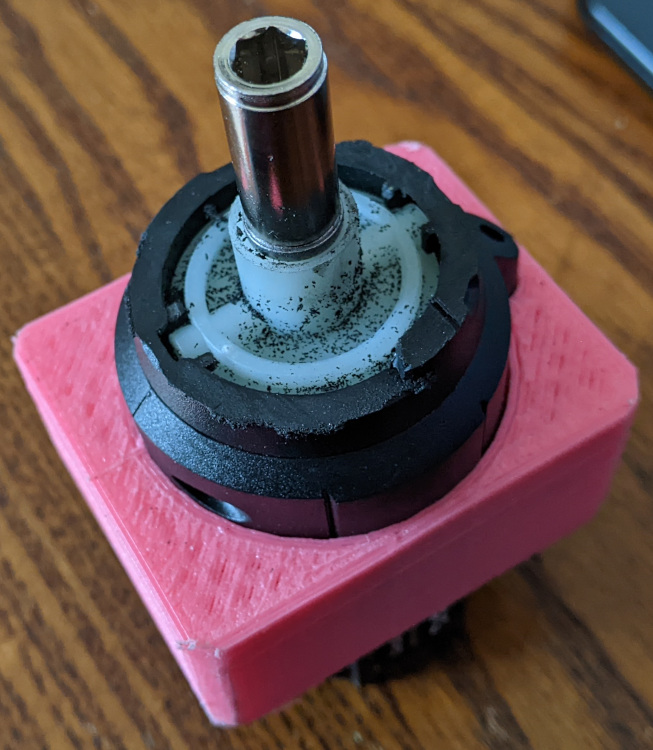I recently purchased a pair of low profile LED ceiling lights from a charity auction on Ebay.
It seemed like the kind of thing that I’d find a use for eventually, and it was for a good cause.
After buying I had a message from the seller to tell me that they only had one driver for the two panels – I went ahead with the purchase because at the end of the day I wasn’t expecting them to be new and pristine from a charity auction.
My curiosity was piqued when they arrived. I noticed another label sticking out from underneath the address label. I peeled it back, and revealed an Amazon delivery label to a different address.
Initially I figured perhaps it was an Amazon returned item – one of the drivers was missing, therefore the original purchaser returned it, and it was sold on to the charity as one of those wholesale return pallets that you see advertised.
I did also think that the wires on the mains side of the LED driver seemed a little bit thin. However I tested it with those panels and they actually seemed to work okay, so I didn’t think much more of it.
Losing faith
So, I started to put together a project plan to make a light fitting with them.
I wanted to add in a few extra accent lights but everything I had was 12v, and the light fittings driver was 18v. While I was mulling over options – adding in a separate transformer, the space and heat issues to work round, etc. I noticed a couple of other things.
The case of the driver seems to have fake screw heads stamped on them. Not in itself a problem, but kind of sketchy.And the panels themselves are stamped with 18w, not 18v.
The output of the driver says 9-18v at 300ma.
W=V*A.
There’s no way that if those panels are 18w, the driver can provide enough power to them.
This made me rethink my theory on the background of these lights.
Having a look on Amazon I can see very similar products, with identical looking drivers – the only difference being that the outputs are rated differently.
My guess is that this set of lights came with incorrect drivers, and the original purchaser damaged one whilst trying it.
It’s only a theory and not enough to make a claim against, it ultimately is enough to destroy my faith in these lights and make me not want to use them as they are.
Rebuilding the electronics
I had built the design around the size of these panels, so I decided to rip out all of the electronics.
On doing so I realized that the panels were just flexible LED strip edge mounted to a diffuser.
I swapped out the LED strip that was there with some white 12v strip LEDs. I had to trim about a millimeter off the sides of the diffuser in order to account for the slightly larger LEDs.
In an initial test the LED light was quite patchy, so I took the diffuser from the second light and doubled up. This makes a notable difference.
To drive the strip I’m using a regular RGB LED control box.
Initially my choice of this was simply because it was available and had a small profile so would fit well in the fitting.
However this also gave me the idea I could run the accent lighting and the main light on different color channels, allowing them to be controlled separately. It would also allow me to dim the light.
The design
Because I don’t want to carve out my ceiling to flush fit the panel I planned to build a small mitred frame, with another frame mounted at forty five degrees behind it. The back frame would contain some accent lights, with the front frame housing the main light fitting.the fitting needed to fit in with the of our lights in the room, so I disassembled the original fitting and spray painted it black.
For the wood frame I opted to use zebrano.
The frames are simple squares with 45 degree mitres, and a 2mm deep by 10mm wide rebate to fit the light fitting frame flush with the surface.
The back frame was turned at a 45 degree angle, and screwed to the front frame.
The back frame also had a pair of key hole plate mounted to the back, which will be used for connecting to the ceiling.
Accent Lighting
Rather than cut up the filters from the second light, I opted instead to use a stack of filters from an old PC monitor. It was simply a case of measuring out the triangles, cutting them and then gluing them in place with hot glue.
Each corner would have a single segment of white LED strip (3 LEDs per corner). These would be connected in series and then connected to the RGB LED control box, on a different color channel to the main light, allowing them to be used independently.
The rest of the electronics
The IR receiver from the control box sticks out behind the front frame, so it is not visible from ground level, but catches enough reflected light from the ceiling to function.
However, this didn't last long and soon found itself wrapped in black tape because what I didn't realise at the time was that the IR receiver worked on the same encoding as our TV remote and we soon bored of having the lights change as we scrolled through TV guide menus.
PSU
The power supply is provided by an AC-DC “wall-wart” – I had to be quite selective in which one I picked to fit within the frame. The one I opted for had a removable face plate which allowed me to remove the socket pins and wire directly into.
The end result






















